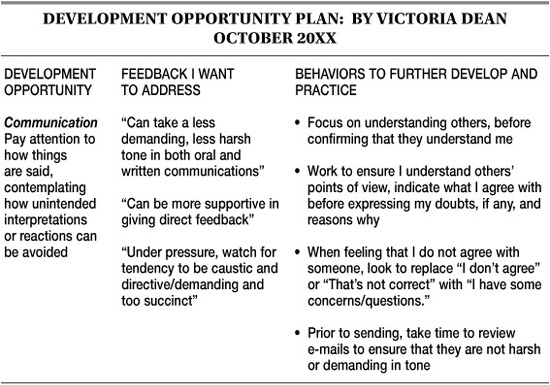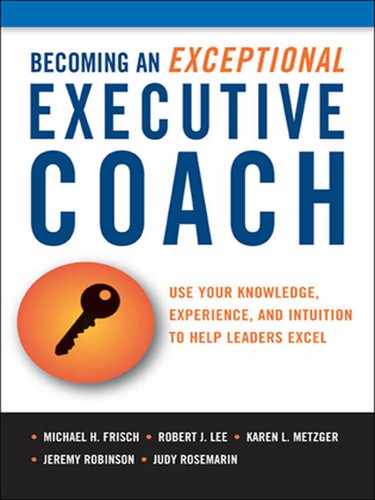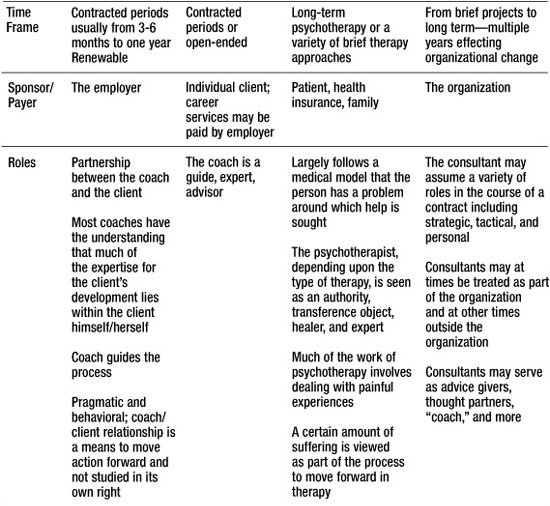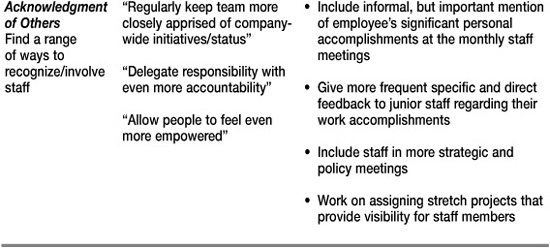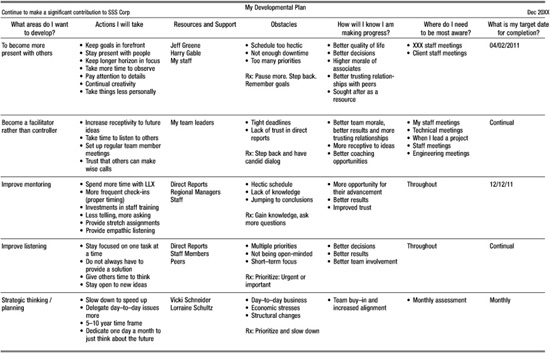Exhibits
Exhibit 1. (Chapter 3) Distinctions Among Executive Coaching, Personal Coaching, Therapy, and Consulting


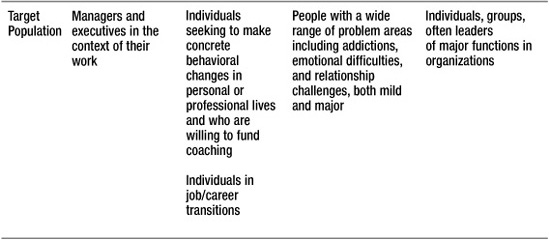

Exhibit 2. (Chapter 5) Sample contract
NOTE: This sample contract is one that takes place after the coach has met once with the HR Director and client’s manager and once with the client. It is written directly to the client; a separate document would be prepared for the sponsors containing fee and payment information.
Sandra Storey, CSW
Executive Coach
Two Connecticut Drive
Jersey City, NJ 00000
Judith Coasten
STL Company
77 Sixth Street
New York, NY 10000
LEADERSHIP DEVELOPMENT PROPOSAL FOR JUDITH COASTEN
PURPOSE
To provide a tailored six-month Leadership Development program for you, Judith Coasten, to help you capitalize on your leadership competence and develop your leadership strengths and influence.
Your program will be informed by Key Development Points, emerging from prior conversations with Robert Heally, SVP of Human Resources, Terrence Thompson, your manager, you, and myself. These Key Development Points are the starting places from which we will narrow down more precise development areas.
KEY DEVELOPMENT POINTS
• Increase self-awareness of your communication style and preferences, your tendency to “react,” and for you to learn ways to pace and adapt to styles different from yours
• Increase your confidence, poise, and competence while making presentations
• Increase your ability to manage difficult relationships with greater finesse
• Learn how to translate your vision into “digestible” and logical steps so that your manager and others can more effectively manage your high-bar expectations
ONE-TO-ONE CONFIDENTIAL MEETINGS
Your program will involve confidential meetings between you and me. For the first four months, we will meet on a weekly basis and twice a month thereafter. Our meetings will take place at your offices/conference room, which you will arrange, and/or in my office. These meetings will last from 90–120 minutes, depending upon schedules, calendars, and needs. In addition, during the course of this program, you will have ready access to me by phone, fax, or e-mail for any questions or support you may need.
Periodically, I will share with your manager where we are in the process. It will not contain the content of our sessions, which is private.
We may select one or more of the following tools to assist you in increasing your self-awareness and your leadership preferences so you can develop the ability to leverage your strengths and focus on areas for development.
1. Listening Skills Profile
2. Leadership Assessment Report
3. Videotaping for feedback on your style and delivery
4. At least one shadowing meeting
5. Stakeholder interviews for input and anonymous feedback
While it is important to have feedback, it is also important to realize that your progress is a process that will become visible to others incrementally.
ASSIGNMENTS
Judith, you will have weekly assignments designed to help you practice the new behaviors, skills, and techniques. Applying them in selected situations and with selected people will help to make each developing skill more natural for you and visible to others.
During your program, we will schedule a three-way in-person conference with your manager and me to share perceptions and assess, support, and sustain your progress. These meetings are key to your progress, since feedback can be invaluable as you move forward.
One of the key deliverables/outcomes of this program is for you to create a strategic Professional Development Plan (PDP) that will emerge from our discussions of the Key Development Points as well as integrating the results from the assessment steps including stakeholder interviews. Your PDP will also act as reinforcement of your developing strengths and as a personalized roadmap for the future.
At the end of the program, we will have a completion meeting where you will present your ongoing PDP to your manager.
It will be critical for us to keep a steady, predictable, and reliable schedule, to the best of our capabilities, since it will be important to keep the momentum of your progress.
“COACHING JOURNAL”
I will also ask you to start and maintain a “Coaching Journal” for the length of your program. Here, you will log and capture your reactions, observations, and any questions that arise during the course of the program. It will act as a log for your successes in your leadership growth; competence and confidence in interactions with your clients, internal staff, and management; and ultimately be your “resource guide” for the future.
I will ask you to write a Final Report on the effectiveness of this program, from your perspective. This report will cover all the Key Development and Learning Points and your evaluation of the total program. The final report may come from the notes from your “Coaching Journal” as well as from any other experiences and reflections.
After the program has been completed, I will provide two follow-through phone meetings, to help ensure your continued success.
FEES
Inclusive fees and billing arrangements have been discussed and approved with your management and will be activated upon signing of and full agreement to this proposal. Payment will be made in two installments, half of which will be paid upon acceptance of this proposal.
TERMINATION
The above outlined Leadership Development Program for Judith Coasten can be terminated with a four weeks’ notification period during this program. Should STL terminate this program, Sandra Storey will return any fees for unused coaching services, minus the four weeks required to terminate the program.
Signed:_______________________Date:_______________________
Signed:_______________________Date:_______________________
Exhibit 3. (Chapter 5) Sample contracting letter to HR sponsor
Roberta Lopez, LLC
Executive Excellence
Five Plate Street
New York, NY 10001
Date
Alan Linux
Global Human Resources
GIB Co.
1700 Beechum Place
New Town, NY 23456
Hello Alan,
Thank you for your call today, and your offer for me to work with GIB Co. and you in regard to coaching Peter Kim. This e-mail will serve as a Letter of Agreement between us for this purpose.
I will provide individual executive coaching to Peter in connection with his current work setting. The general goal, as I now understand it, will be to partner with him as he considers how to manage the conflicts in his work setting.
This Agreement will be effective as soon as you approve it, and will continue for six months. We can consider renewing the contract for another six months as the initial contract comes to a conclusion.
The specifics of how often, for how long, and where Peter and I will meet will be discussed by us at our first session. The typical pattern, however, is for me to meet with clients each week for two hours or so in the early weeks, and somewhat less frequently as time goes on—perhaps two or three times a month. Sometimes there are longer sessions in the beginning of a coaching relationship. Most of these meetings will be in my office but some will be in his office location. Inevitably there also are telephone sessions and e-mail exchanges.
It will be essential to meet with Peter’s manager, Athena. It may also be appropriate for me to meet with or talk by phone with others in GIB, as agreed by Peter and myself.
Periodic “progress” reports will be communicated to you and/or Athena, with the understanding that the content of the coaching conversations will remain confidential to Peter and myself.
The fee for the coaching is $xxx. I prefer to submit one invoice, approximately a month into the engagement.
These are the major items for our Agreement. If you wish me to sign a Nondisclosure Agreement, I’ll be pleased to do so.
Please let me know if you have questions about this Agreement. I look forward to working with you!
Sincerely,
Roberta
Exhibit 4. (Chapter 5) Sample proposal
Mitch Evans, Ph.D.
Executive Coach
18 West Avenue
New York, NY 10001
Date
Ron Smith, Controller &
Laurie Franks, Director HR
XYZ Capital
1 West 50th Street
New York, NY 10020
Dear Ron and Laurie:
I really enjoyed meeting with both of you this morning to discuss the possibility of providing leadership coaching to Ron. I have been providing coaching services to managers and executives for over 20 years and have a 30-year career as an organizational psychologist (you have my biosketch). I am currently engaged in a variety of coaching assignments in financial services companies.
As Ron and I discussed, he has a long-standing commitment to his professional growth and development but has not had formal courses on leadership or management. In addition, he would like help in expanding his managerial repertoire so that he can be more direct when the situation requires it. His openness to learning coupled with his awareness of areas he would like to work on are very positive predictors of growth through coaching. In addition, it may be useful for Ron to attend a leadership development or managerial skill course, possibly later this year, which would build on his progress in coaching.
I will use this letter to outline steps and fees for the type of coaching program that Ron and I discussed. For clarity, I have separated coaching into two connected phases, with a third phase of follow-up support to be structured later. The initial two phases are: 1. Relationship Building and Needs Assessment 2. Active Coaching. Each is described below.
1. Relationship Building and Needs Assessment
This phase includes the following steps (some steps could overlap):
• Assuming Ron and I are in agreement to proceed, we would meet again to confirm steps in the coaching process and discuss in more detail his career, challenges, strengths, gaps, and aspirations to begin shaping possible development themes and action ideas
• I would interview Ron’s manager, Bill, to gather his perspective about Ron’s strengths and development areas
• Coaching often taps peers and direct reports to get the most complete picture of how the client is viewed so I would also interview Ron’s direct reports and a sample of peers and internal clients
• If there is interest, I can also provide standardized assessments to Ron using tools such as the MBTI (Myers-Briggs Type Indicator) to add to the self-insight process
• I would analyze the results of the interviews and other information and distill themes into a feedback summary, which would be presented to Ron for a thorough discussion
• Based on that information, Ron and I would draft a development action plan aimed at strengthening and broadening his leadership style. It would identify 2–3 key development goals as well as on-the-job action ideas to make progress on those goals
• We would share that draft development plan with HR and Bill to reach consensus and get everyone’s active support for implementing Ron’s development efforts
2. Active Coaching
Building upon the development plan, this phase increases developmental activity:
• Ron and I would meet biweekly (every other week) for coaching meetings of 1–2 hours each, in a conference room at XYZ
• The focus of these meetings would be to make progress on the developmental objectives by implementing the action ideas outlined in the development plan; support for and adjustments in action ideas would also be made to take advantage of emerging situations
• Discussions would focus on the application of new self-insight and management tactics, approaches to current work challenges, adjustments in leadership style, overcoming challenges, and other topics
• I would be available to Ron via phone and e-mail for just-in-time consultation on management, leadership, or other questions that arise
• I am prepared to teach management, leadership, and other skills that support the changes envisioned in the plan
• I would recommend management and leadership books and other materials as helpful adjuncts to the development plan; management and leadership courses would also be identified
• Regular contacts by me with HR and Bill to get feedback on progress and understand any emerging organizational issues relevant to Ron
3. Follow-up Support
A supportive follow-up phase is often part of coaching. It usually involves a less intensive schedule between coach and client while still providing guidance and support. It can be structured in many different ways (e.g., monthly meetings, phone contact, quarterly meetings, e-mail). We can determine how to structure this phase to meet Ron’s and the organization’s needs and interests when we are closer to it.
This would be especially important after Ron attends a leadership development course, possibly later this year, that would build on his progress in coaching. Follow-up coaching would help him assimilate the learning from the course and apply it to his leadership responsibilities. Such a course would also be useful in evaluating his progress on development since it usually includes a 360-degree survey as pre-work.
I prefer to invoice monthly for direct professional time rendered in my coaching work and my invoices describe the work that was performed during the past month. I invoice using my company name and would be happy to provide whatever information is required for your vendor system, including signing a W-9 and Non-Disclosure Agreement (NDA). The upper limit of the estimated range for each phase is calculated based on my hourly rate and represents a ceiling; unless we were to discuss special circumstances, you could assume that hours and fees would not exceed that amount and may in fact be lower, depending on progress.
The only items not included in the fees above are: 1. out-of-pocket expenses associated with travel or other direct expenditures (assessments, books, etc.), 2. actual time I am required to travel to deliver coaching services, and 3. appointments canceled on short notice. Here is how I handle each of these: 1. Out-of-pocket expenses, such as test fees, travel, and meals are simply included on my invoices with the required documentation. For work in Manhattan there would be no travel expenses. 2. For my travel time, my practice is to invoice for half of the actual time I am in transit, after the first 30 minutes each way. In other words, there are no fees for normal commutation to the client’s site in Manhattan. 3. Finally, I reserve the right to charge, based on my hourly rate, for appointments canceled on short notice (less than a week). Should any of these 3 items apply, they would be in addition to the fees outlined above for delivering the coaching services.
The contents of all coaching conversations, feedback reports, and assessment results are confidential between Ron and me. The development plan, however, is not confidential and is meant as a guide for all parties invested in Ron’s development. Obviously, I would seek regular contact with Bill and HR to gain views on Ron’s progress and discuss ways in which to support that progress.
I hope this proposal letter adequately outlines the executive coaching that Ron and I discussed. Let me know if any questions arise. I am prepared to begin working with Ron in the next week, pending the appropriate approvals.
I look forward to working with XYZ on Ron’s development.
Sincerely,
Mitch Evans, Ph.D.
Exhibit 5. (Chapter 10) Verbatim feedback report
CONFIDENTIAL
Informational Interviews on Behalf of Rachel Munez
NOTE: In choosing to use verbatim comments made by participants across perspectives in the informational interviews, the coach believed it was important for Rachel to hear the frequency and consistency of positive comments and suggestions. The coach noticed that Rachel, while competent in her work, had a consistent thread of self-doubt and displayed a lack of confidence. The coach believed that hearing the exact words rather than summarizing or consolidating responses would be the best way to show Rachel that others not only believed in her, but wanted more of her observed effective behaviors. The perspectives of Group #1 Colleagues/Internal Clients, Group #2 Senior Managers/Leaders, and Group #3 Her Direct Manager were virtually the same and also reported to her verbatim.
What are the activities or areas where Rachel functions most effectively? What would you like to see continue?
In what areas are there opportunities for Rachel become more effective? What are areas for improvement?
Suggestions/Professional Development In what new areas would you like Rachel to get involved or further leverage her skills?
GROUPS #1, 2, and 3
Strengths/Effective
• Go-to person for problem resolution, having created comfortable and direct relationships
• Takes care of problems: gathers facts; walks through the process; provides emotional support
• Relates well to employees and managers; makes others feel comfortable around her
• Makes it seem like you can go to her for anything; not intimidating
• Clearly maintains confidentiality; listens well; good sounding board
• Reacts quickly to concerns and needs; very responsive in person and e-mails
• Her responses show concern and interest
• Has a strong focus on the organization and what’s important
• Easy to reach out to, to talk to, and trust even if have differences
• Checks out the buzz; asks about what might be less visible to her and what managers are hearing
• Follows up; explores, plans, conducts thorough due diligence; gets back to you
• Probes others’ thinking
• High professionalism; demonstrates honesty and integrity beyond reproach
• Gives feedback that is useful and without judgment; strong at having difficult conversations; can deliver tough information sensitively and in the least hurtful way
• Shows patience with frequent conversations; encourages opinions and stretch
• Friendly and open to casual conversation, which can lead to additional guidance/suggestions
• Acknowledges strengths in others; helps them feel important and encourages contributions
• Inspiring and a model for tough yet compassionate work
• Aggressive in dealing with knotty issues
• Nonjudgmental, open, accessible, and interested
• Assesses tough situations; explores alternatives; and involves the manager and employee in seeking solutions
• Diplomatic and takes the middle ground, balancing the company’s interest and mine
• Helps clarification of goals; guides and advises in reaching a solution
• Counsels managers to be more effective in handling individuals (who are new to the organization and those around a long time)
• Conducts herself objectively; doesn’t seem to allow friendships to get in her way
• Creates trust and confidence and respects confidentiality
• Provides concise, well-defined advice
• Creates an atmosphere of warmth, comfort, and uses humor; interacts on professional level that is also casual, fun, and welcoming
• Gives clear presentations reflecting preparation; fields questions
• Demonstrates positive forward thinking and collaboration
• Brings a level-headed perspective; sensitively helps manager work through challenging situations
• Checks in with managers to see what may be cropping up
Areas to Become More Effective
• Could be more proactive/frequent in checking out if there are unaddressed wants and needs
• Meet even more frequently with managers to provide more unsolicited but helpful feedback to managers
• Can help me in defining more junior people’s skill sets
• Because of her talent making sense of issues, it would be nice if she could spend more time learning and checking on subtle staff needs and issues and raising them with managers
• Informally get to know the staff more to create more access and further enhance services
Suggestions/Professional Development
• Continue being out there and knowing what’s going on within the organization
• Use more of her capacity for providing support
• Create more opportunities to work with managers to uncover areas in which she can be additionally helpful
• Might be more deliberate and frequent checking in with managers
• Manage expectations on big projects—clarify status; give more frequent updates
• Raise self-confidence level while working on new initiatives
Exhibit 6. (Chapter 10) Feedback summary
Personal and Confidential
Feedback Summary
Thomas Jones
Large Company Inc.
September 2010
This summary is based on 14 confidential interviews conducted by your executive coach: 5 were with outside Board members, plus the Chairman of the Board, and 8 were with members of the Executive Committee. On average, interviews lasted 45 minutes. A consistent interview format was utilized that focused on strengths to continue leveraging, gaps or areas to improve, as well as targeted questions about fostering greater teamwork and key short-term priorities. Interpretations are derived as closely as possible from interview content, consistent with capturing insights and protecting individual interviewee identities.
Unless noted, themes were highly consistent across all interviewees.
Strengths to Continue Leveraging
• Embraces COMPANY history and committed to maintaining the COMPANY culture
• Deep operational experience and project management expertise
• Tough minded re project plans and budgets
• Analytical; considers issues logically and thoroughly
• Willing to face tough organizational decisions fairly and in a timely manner
• Honest, credible, trustworthy; puts the well-being of COMPANY as a whole first
• Steady, stable, and dependable; stays the course and reduces risk
• Open to learning and addressing areas for professional growth
• Command attention; executive bearing
There were many unsolicited comments about trust and respect for you. While this has been a difficult period of time, there was unequivocal support for your leadership.
Gaps or Areas to Improve for Enhanced Effectiveness
Nonetheless, interviewees were very forthcoming with suggestions about how to fulfill your role. Not surprisingly, under this topic outside Board members had a somewhat different focus than the Executive Committee members, which can be summarized as external/big picture vs. internal leadership style issues. The Board emphasized the first four bullets while the Executive Committee emphasized the second four bullets, but feedback overall was highly consistent.
• Shape the vision of the future COMPANY and the resulting medium to long-range plans.
• Shift focus from US operations to Global COMPANY ventures; must fully delegate leadership of the areas you know best.
• Represent COMPANY in industry, customer, and professional associations and meetings.
• Increase market and marketing focus in extending COMPANY’s reach to customers.
• Decision process could be more collaborative by having more give-and-take during discussions and more iteration as your views are being formed.
• More often choose relationship building rather than progress on your own tasks; take advantage of opportunities to interact with others even if unscheduled or informal.
• Channel your frustration and disappointment into words about the gaps between what you expected and what you got; angry e-mails, voicemails, or public “dressing downs” drive others away.
• Reach out and seek help on areas that would benefit from input and/or are not strengths (e.g., overseas ventures, and other thorny issues); such input can come from many sources including internal staff, outside Board members, outside advisers.
Exhibit 7. (Chapter 11) Sample development plan
Confidential
Kile Smith
Director, Systems Development
Big Bank USA, Inc.
This document is based on data-gathering interviews, standardized self-development questionnaires, and information supplied directly by Kile to provide a foundation for growth and development.
Strengths
• Intellectually quick; grasps details rapidly and thoroughly
• Analytical skills in evaluating alternatives; logical
• Grasps the big-picture view of projects; strategic
• Savvy understanding of business applications; financial rationale (ROI)
• Accountable; committed to delivering results; gets things done
• Project management skills: tasks, dates, paths, and stakeholders
• Able to partner with others; collaborative problem-solving skills (with some inconsistency)
• High standards for self and others
• Concise communication; gets to the point efficiently
Development Goals and Representative Actions
I. Upgrade skills in managing the performance of others.
Start/Increase:
• When work is delegated, contract with direct report about due dates, check points, and deliverables; conduct this contracting as a discussion and hear out concerns even if there is little flex in expectations
• Adjust your delegation style to fit the readiness of the direct report for the task, shifting from hands-off empowerment to closely monitored/directive as indicated by Situational Leadership
• To the extent possible, explicitly link assignments to a direct report’s gaps, interests, or career aspirations; where possible, make clear the developmental value of an assignment
• When your expectations are disappointed, provide timely and frank feedback to direct reports; listen to their reactions and together shape an improvement plan
• When priorities change or unanticipated tasks infringe on already contracted work, discuss overt adjustments in the commitments made; agree on new time frames
• Provide a big-picture perspective for task or project goals
• Acknowledge accomplishments one-on-one and as a group
• Criticizing or making comments that could be interpreted to undermine direct reports when others are present
• Ignoring changes in priorities that have delayed attention to contracted tasks
• Dictating how something should be done when there are multiple acceptable paths; overcontrol
II. Consistently build collaborative relationships. Start/Increase:
• Get to know others beyond the essentials for task delivery.
• Signal your approachability with both verbal and nonverbal cues, especially with new team members and those you haven’t worked with before.
• Consider the extent to which your e- and voice-mail messages invite involvement or distance others from you.
• Where possible, expand your contacts by talking with people you don’t know well.
• Apply active listening skills to explore others’ points of view, and keep an open mind to new ideas, even when in your own thinking you favor a particular approach.
• When others have not lived up to your standards, use listening skills to understand rather than judge them; at the same time, express your reactions honestly using “I” language.
• Monitor your stress/fatigue; try to ameliorate feelings of high pressure/stress, especially anticipating situations not under your control.
• Push back/renegotiate priorities when unexpected but important work disrupts previously made plans; avoid repeatedly sacrificing work/life balance.
Stop/Decrease:
• Nonverbal cues that signal frustration or anger
• Verbal tone or comments that imply blame and negative judgment
• Clipped, demanding, “all business” interactions with others
Exhibit 8. (Chapter 11) Sample development plan
